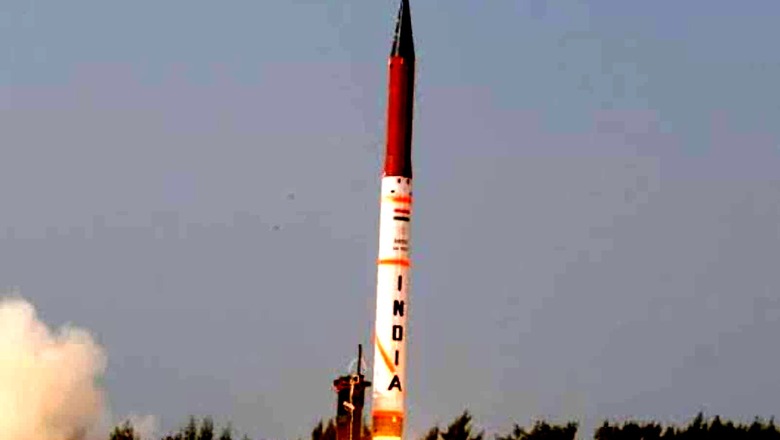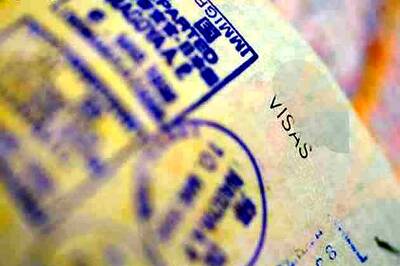
views
India recently issued a NOTAM notice declaring the Bay of Bengal a no-fly zone ahead of another Agni-V ballistic missile test scheduled for December 15-16 from Abdul Kalam Island off the coast of Odisha.
The development comes amid the reported movement of a Chinese research vessel in the Indian Ocean Region (IOR). According to data collected by the Norwegian company Maritime Optima, as reported by ThePrint, Yuan Wang 5 re-entered the Indian Ocean region earlier Monday. The report stated that the Yuan Wang 5 was currently southbound in the Indian Ocean off the coast of the Indonesian island of Java.
The news comes just a week after India issued a NOTAM (Notice to Airmen/Notice to Air Missions) about a missile test in the Andaman and Nicobar region, and just a few days after the Yuan Wang 5 appeared to reverse course in response to India’s NOTAM, the report further said, adding that on 2 December, open source geospatial intelligence analyst Damien Symon speculated on the return of the Chinese vessel to the Indian Ocean region.
Amid the developments, News18 explains the Agni V missile, China’s interest in the Indian Ocean Region and why it’s an issue.
About the Agni V Missile
Agni V is India’s long-range surface-to-surface ballistic missile, capable of hitting a target 5,000 kilometres away with pinpoint accuracy. This range puts almost the entire country of China within the missile’s range. Though an ICBM requires a missile with a range of at least 5,500 km, India’s closest contender for an ICBM is the Agni 5, which can reach countries on other continents, including parts of Africa and Europe, a report by Indian Express explains.
Though the government claims that it has a maximum range of around 5,000 kilometres, several reports indicate that it can hit targets as far away as 8,000 kilometres, according to the report. The nuclear-capable missile can carry a warhead weighing around 1,500 kg and has a launch weight of 50,000 kg, making it one of the country’s most powerful missiles.
In 1989, India began testing the Agni missile series, with the first test for Agni I, an Intermediate Range Ballistic Missile with a range of around 1,000 kilometres. At the time, only the United States, the former Soviet Union, China, France, and Israel possessed IRBM technology. Since then, DRDO labs have continued to work on it, bringing the latest available Agni V to its current capability. In addition to the IRBM-capable nations, only North Korea and the United Kingdom currently have ICBM technology.
China in Indian Ocean Region
The spy research ship is one of four active ships in the Yuan Wang-class, which is in charge of tracking and supporting satellites as well as Intercontinental Ballistic Missiles (ICBMs).
The Agni-V has a declared range of 5,000 kilometres, allowing it to strike deep into China, which is why this ballistic missile has caused such consternation in China, a report by Firstpost explained.
It remains to be seen whether the missile will be tested on time or if the timing will be altered. The time was changed last month when the Agni-III missile with a range of 3,000 km was tested, a report by Firstpost said.
All countries are permitted to navigate their ships in international waters. That is why India cannot stop the Chinese spy ship, which is part of the PLA’s Strategic Support Force and its primary mission is to track and support satellites and ballistic missiles. Chinese ships frequently visit the Indian Ocean to gather data and create oceanographic maps.
China’s Interest in IOR
China recently conducted a “China-Indian Ocean Region Forum” on November 21 in Kunming. The China International Development Cooperation Agency (CIDCA) meeting is the latest Chinese initiative focusing on the Indian Ocean Region (IOR), highlighting Beijing’s growing strategic interests in a region where its economic footprint is expanding, a report by The Hindu explained.
According to the CIDCA, China’s new development aid agency, which is currently led by former Vice Foreign Minister Luo Zhaohui, the forum was “the first high-level official development cooperation forum jointly held by China and countries in the Indian Ocean Region,” with “over 100 participants, including senior officials from 19 countries bordering the Indian Ocean.”
The forum issued a “Joint Press Statement” in which it stated that China “proposed to establish a marine disaster prevention and mitigation cooperation mechanism between China and countries in the Indian Ocean region” and “all parties agreed” to “strengthen policy coordination, deepen development cooperation, increase resilience to shocks and disasters, and enhance relevant countries’ capacity to obtain economic benefits through use of marine resources such as fisheries, renewable energy, tourism, and shipping in a sustainable way,” the report said.
The report explained that the forum has highlighted China’s increased interest in the IOR, where it is already a major trading partner for the majority of countries and where sea routes are critical to China’s economic interests. The CIDCA forum is the latest initiative to reflect Beijing’s view that it has a clear stake in the region, with more to come. Earlier this year, during a visit to Sri Lanka, China’s Foreign Minister Wang Yi proposed establishing a forum “on the development of Indian Ocean island countries” to “build consensus and synergy, and promote common development.” He urged Sri Lanka to “play a significant role” in this initiative. The increased regional diplomacy comes as China establishes a more frequent military presence in IOR waters. Beijing established its first overseas military base in Djibouti, near the Horn of Africa. Chinese military ships, tracking vessels, and submarines have become more frequent visitors to the region’s ports.
With at least 355 warships, China’s PLA Navy (PLAN) is the world’s largest naval force. Aside from that, it has established logistics bases in Cambodia, Seychelles, and Mauritius, as well as in East African countries.
Read all the Latest Explainers here




















Comments
0 comment